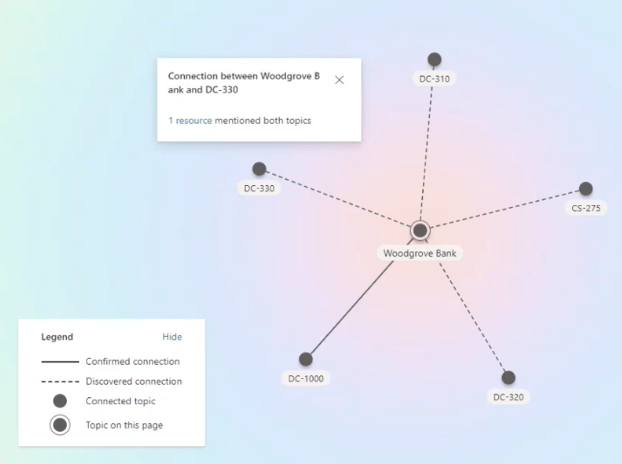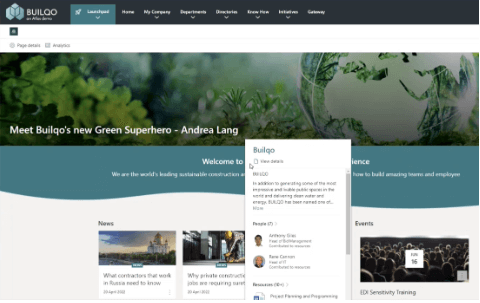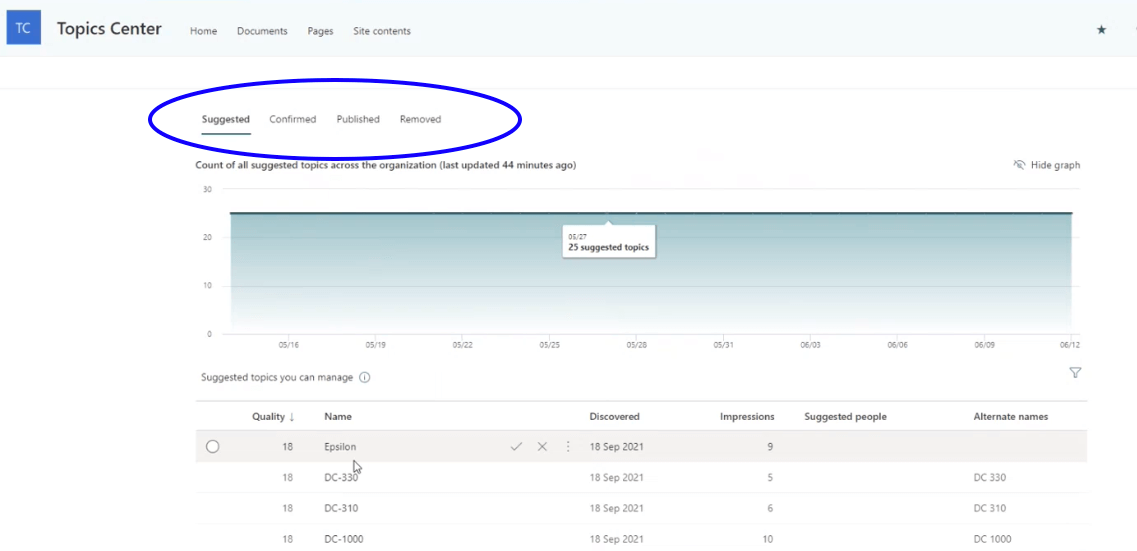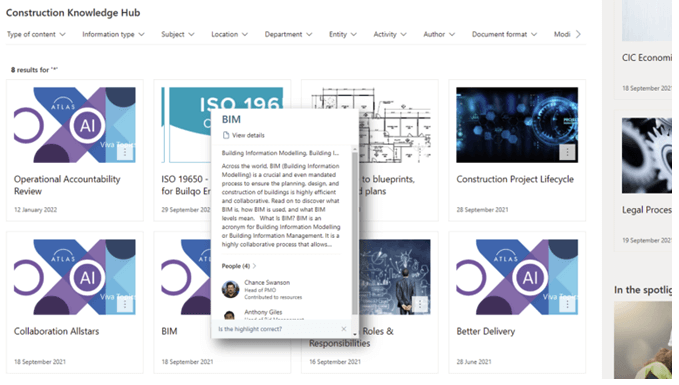In early 2021 Microsoft launched Microsoft Viva as an employee experience platform designed specifically to help businesses manage the changes brought about by hybrid working.
For many people, Microsoft Viva’s appearance in our daily working lives has become quite familiar, but there are still the finer points of the full Microsoft Viva offering that could do with a closer look. In this blog, I’m focusing on Viva Topics and I chatted to ClearPeople Director & Co-Founder Gabriel Karawani to provide an overview – and a review – of Viva Topics.
Microsoft launched Microsoft Viva to help people and businesses adapt to the rapid and fundamental ways the pandemic changed the way we work. Realizing that remote and hybrid working brought many benefits, but also made it more difficult to connect people and teams, Microsoft built an employee experience platform onto Microsoft Teams and Microsoft 365.
Microsoft Viva builds on Microsoft Teams and Microsoft 365 to enhance the employee experience across 4 key areas: engagement, wellbeing, learning and knowledge.
Microsoft describes Microsoft Viva as "the first employee experience platform to bring tools for employee engagement, learning, wellbeing and knowledge discovery, directly into the flow of people’s work. Viva is designed to help employees learn, grow and thrive, with new experiences that integrate with the productivity and collaboration capabilities in Microsoft 365 and Microsoft Teams."
Microsoft Viva Topics is an AI-based solution that helps to organize and structure knowledge. The two components of this AI engine are Machine Learning and Natural Language Processing. The AI runs in the background continuously trying to discover and understand connections between content, content sources and people. The AI’s most important job is then to assess how to sensibly group these connections together. Those “groups of content, people and connections” are evaluated by the AI and if it determines that enough sensible connections are present, it will present this as a suggested “Topic”.

Practically speaking, when the AI suggests a Topic, it creates a dynamic Topic page that includes alternate names and acronyms for the Topic, a short description of what it is, people connected to it and any relevant files, pages and source sites.
A summary of the Topic is displayed as a card which automatically appears when you hover over the matching term in a text area in, for example, a SharePoint page. That way, you can immediately learn what a Topic is, without having to leave the context you are in.
In the screenshot below, for example, the user has hovered over the term ‘Builqo’ to read the Topic card about Builqo, without having to search for it, or leave the page the user is on. The Topic card describes what Builqo is and lists people associated with it so you can easily learn more and who to talk to if you need further information.

The AI engine respects permissions and is sensitive in terms of working out who can see what within a Topic. Cleverly, the Topics service automatically attempts to describe the Topic. Sometimes this description is pulled from a public source such as Wikipedia, but it other instances, it might be pulled by the AI from a relevant internal document. The AI will even present different descriptions from different documents depending on the user’s permissions.
While the AI does a lot of the leg work pulling resources together, Subject Matter Experts (SMEs) can refine (curate) each Topic further. SMEs can confirm, edit and publish whole Topics or choose to remove irrelevant ones. The AI learns from all this input. As an individual end-user, if you’re associated with a specific topic, Viva Topics will prompt you for feedback. The more feedback you provide, the more accurate information on that Topic will be. Viva Topics will also use feedback to determine whether a Topic has been correctly identified on a page, if it’s valuable to the organization, and whether the people and resource suggestions are helpful. If enough people indicate that a Topic isn’t useful, it will be rejected.

You may be wondering what other knowledge tools are available and how Viva Topics compares to them. Well, I was, so I spoke to Gabriel about that and learnt that there aren’t really any other tools that do exactly what Viva Topics does.
“There are other tools that do document or content discovery, and present things in different ways using AI, so there are competitive tools out there,” he says. “But it’s very difficult to find like-for-like comparisons – especially if you want it to work within your Microsoft 365 environment.” One of the reasons is that this still a new market, but certainly a space we’re likely to see a lot of growth in.
In terms of scoring and reviewing Viva Topics, Gabriel says one of Viva Topics’ outstanding features is the simplicity with which it does something very complex. The effort of getting Viva Topics up and running for your organization is minimal.
There are a few administrative steps to take, but Viva Topics is a tool an organization can implement – technically speaking - in a matter of hours. Organizations will naturally need to consider how it will be adopted, how users will engage with Viva Topics and how to engage Knowledge Managers and SMEs in the curation process. But the actual technical work to get Viva Topics operating is limited, particularly in comparison to many other AI tools.
“This is effective black box AI,” Gabriel explains. You don’t need data scientists, to create models, or big data sets to test your AI engine. Companies don’t need to invest in a lot of additional resource or capability to get this running. The trade-off is that you don’t have the flexibility you might have with other tools.
Anyone in the organization who understands a Topic can work on a Topic page, pin files, locations and people. And every time someone does that, they provide feedback to the AI. Viva Topics is effectively accessible AI technology which hides the complexity of running machine learning and natural language processing.
If he were to review Viva Topics, Gabriel says he would score it 8 or 9 out of 10. “It’s relatively inexpensive, it’s easy to get to, easy to implement and it actually works,” he says. The only reason he doesn’t score it higher is that while the technology works very well, it’s still difficult to get users to adopt it and use it in the flow of their daily work. But this is something Microsoft is working on, and we can expect to start seeing Topics become part of the email and Teams conversations experience in time.
If you’re an Atlas client, you can likely picture that Atlas and Viva Topics would complement one another, given that knowledge management is one of Atlas’ key strengths. Gabriel explains exactly how this relationship works.
Atlas is unique in that it provides a consistent way of managing content across 1000s of Teams, SharePoint sites, connecting all content into a single end user experience. The result is that people can see all the content relevant to a project, department or customer within the relevant context – of for instance a project workspace. Or that people can consistently search and find content – across the 1000s of Teams and SharePoint sites.
Viva Topics allows us to go one step further. Viva Topics looks across all of the above – but also outside of any structured information management area. Think of all the document libraries with hundreds or thousands of documents that no one really looks after. The thousands of folders as a result of migrations. The folders and folders of content for dormant activities., connects all the uncurated content, the content outside of Atlas that’s sitting in files and folders inside SharePoint libraries, in documents in some data abyss within SharePoint that no one is ever going to get around to reordering. As a result Atlas dynamically brings Topics in to the relevant Atlas workspaces, Knowledge Pages and search experiences. It’s a symbiotic relationship: Viva Topics makes Atlas better, and Atlas makes Topics better.
In this screenshot below you can see how Atlas blends relevant Topics with other knowledge. This example is in the Construction team’s Knowledge Hub, where we are seeing tiles for knowledge documents, knowledge pages and Viva Topics in one consistent experience:

In this example, you can see Atlas integrates tightly with Viva Topics, bringing the Viva Topics hover card into the context and links the user to the full Topic page with more detailed information.
On this Viva Topics page for “BIM” Atlas extends the capability for the user. So now, with Atlas, the user will see other related knowledge, whether they are related Viva Topics, Knowledge Pages or Documents.
By making information readily and easily accessible through AI and automation, Microsoft Viva Topics helps businesses realize a number of benefits:
CLEARPEOPLE TIP: Viva Topics’ ability to discover and connect content across your Microsoft 365 apps can result in an overwhelming number of Viva Topics. Read this blog about how to exclude suggested Viva Topics.
Automatically identifies topics
Recognizes common topics across content and conversations, organizes information, and generates topic pages.
Finds related topics and people
Discovers and displays complementary topics and expertise across sources.
Automatically builds topic pages
Creates topic pages and topic cards using suggested definitions, related content, relevant conversations, and expertise.
Curation
Cultivates knowledge using your subject matter experts and AI to refine topic pages.
Highlights topics
Shows topic highlights and displays Topic Cards in any Microsoft 365 app.
Makes topics accessible
Gives people the information they need anytime, anywhere.
Microsoft Viva Topics currently surfaces information in four places:
• Highlighted on SharePoint pages
• Via Topic answers in search results
• When you search within an Office applications
• In the Topic Center homepage
As mentioned above, Atlas extends this much further across departmental, subject matter and search experiences.
Microsoft offer an interactive demo and a free trial of Viva Topics. Find out more here: Knowledge and Expertise | Microsoft Viva Topics
For information on how to set up Microsoft Viva Topics and various useful tips, have a look at the walk-through we created.
Which brings us to where Viva Topics is headed. Viva Topics was released in early 2021. Since then, the following has been added:
Viva Topics in Outlook for the web
You can manually use hashtags to attach topic cards to any message. Viva Topics can then display those to your readers with suggested additional topics in the message pane.
Viva Topics insight analytics
As soon as Viva Topics is activated for your Microsoft 365 tenant, you’ll see a count of the files processed and topics that are discovered from those files. As more topics are discovered, and your knowledge managers and users are engaged, you will see a visible topics count and a breakdown of the topics discovered, created by users, hidden by settings and removed.
As of mid-2022, Microsoft says the following will be coming later in the year:
Depending on your location and other factors, Microsoft’s list price is £3/$4 per user per month and £6.80/$8 per user per month when bought as part of Microsoft Viva Suite.
More pricing information is available on Microsoft's websiteSubscribe to our newsletter
This site is protected by reCAPTCHA and the Google Privacy Policy and Terms of Service apply.